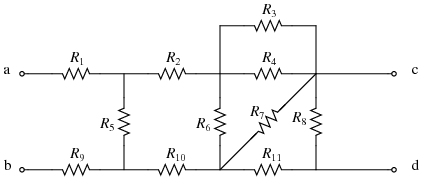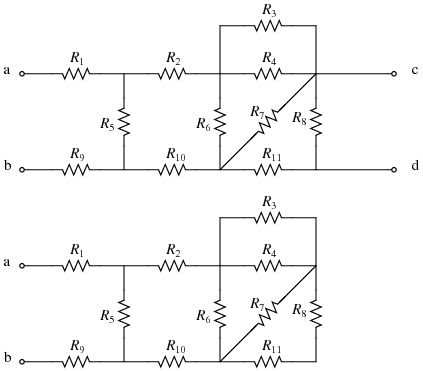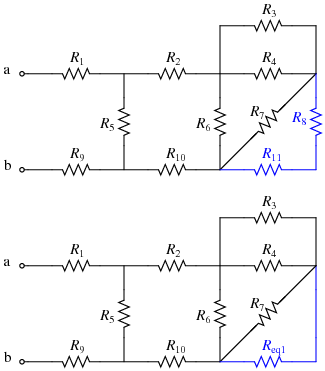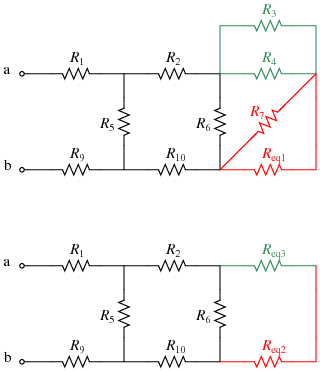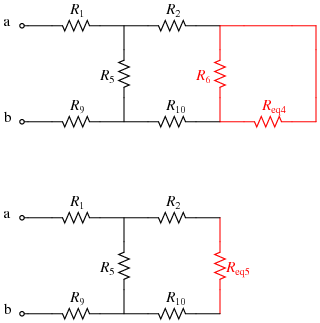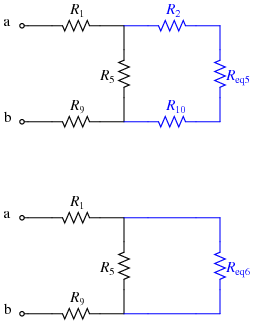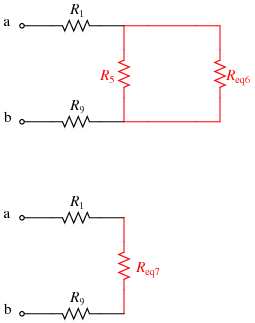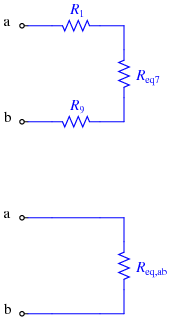Difference between revisions of "Examples/Req"
Jump to navigation
Jump to search
| Line 1: | Line 1: | ||
| − | The following shows two step-by-step examples for find the equivalent resistance between two nodes for | + | The following shows two step-by-step examples for find the equivalent resistance between two nodes for the following network: |
| + | <center> | ||
| + | [[File:R_0.png]] | ||
| + | </center> | ||
| + | |||
| + | In particular, this example demonstrates how the same network of resistors might reduce differently depending up which two nodes in the network are of interest. Each figure shows the "before" and "after" of a particular step. | ||
== <math>R_{ab}\!</math>== | == <math>R_{ab}\!</math>== | ||
For the first example, we will find the equivalent resistance between nodes a and b. | For the first example, we will find the equivalent resistance between nodes a and b. | ||
* Start by focusing only on nodes a and b | * Start by focusing only on nodes a and b | ||
| − | + | <center> | |
| + | [[File:Rab_1.png]]<br /> | ||
| + | <math>R_{eq1}=R_8+R_{11}</math> | ||
| + | </center> | ||
* Next, combine any resistances that are in series. In this particular case, R8 and R11 are now in series because the wire leading to node d has been eliminated. Replace this combination with Req1: | * Next, combine any resistances that are in series. In this particular case, R8 and R11 are now in series because the wire leading to node d has been eliminated. Replace this combination with Req1: | ||
| − | + | <center> | |
| + | [[File:Rab_Req1.png]] | ||
| + | </center> | ||
* Since no resistors are current in series, now look for resistors that are in parallel. R7 and Req1 are in parallel; also, R3 and R4 are in parallel. Replace each with their equivalent resistances (named Req2 and Req3, respectively): | * Since no resistors are current in series, now look for resistors that are in parallel. R7 and Req1 are in parallel; also, R3 and R4 are in parallel. Replace each with their equivalent resistances (named Req2 and Req3, respectively): | ||
| − | + | <center> | |
| − | + | [[File:Rab_Req23.png]] | |
| + | </center> | ||
* Now note that Req2 and Req3 are in series; replace them with Req4: | * Now note that Req2 and Req3 are in series; replace them with Req4: | ||
| − | + | <center> | |
| + | [[File:Rab_Req4.png]] | ||
| + | </center> | ||
* After that step, R6 and Req4 are in parallel; replace them with Req5: | * After that step, R6 and Req4 are in parallel; replace them with Req5: | ||
| − | + | <center> | |
| + | [[File:Rab_Req5.png]] | ||
| + | </center> | ||
* Next, note that R2, R10, and Req5 are in series; replace them with Req6: | * Next, note that R2, R10, and Req5 are in series; replace them with Req6: | ||
| − | + | <center> | |
| + | [[File:Rab_Req6.png]] | ||
| + | </center> | ||
* Given that network, R5 and Req6 are in parallel; replace them with Req7: | * Given that network, R5 and Req6 are in parallel; replace them with Req7: | ||
| − | + | <center> | |
| + | [[File:Rab_Req7.png]] | ||
| + | </center> | ||
* Finally, R1, Req7, and R9 are in series; replace them with Req,ab, the overall equivalent resistance between nodes a and b: | * Finally, R1, Req7, and R9 are in series; replace them with Req,ab, the overall equivalent resistance between nodes a and b: | ||
| + | <center> | ||
| + | [[File:Rab_Reqab.png]] | ||
| + | </center> | ||
Revision as of 20:40, 13 January 2013
The following shows two step-by-step examples for find the equivalent resistance between two nodes for the following network:
In particular, this example demonstrates how the same network of resistors might reduce differently depending up which two nodes in the network are of interest. Each figure shows the "before" and "after" of a particular step.
\(R_{ab}\!\)
For the first example, we will find the equivalent resistance between nodes a and b.
- Start by focusing only on nodes a and b
- Next, combine any resistances that are in series. In this particular case, R8 and R11 are now in series because the wire leading to node d has been eliminated. Replace this combination with Req1:
- Since no resistors are current in series, now look for resistors that are in parallel. R7 and Req1 are in parallel; also, R3 and R4 are in parallel. Replace each with their equivalent resistances (named Req2 and Req3, respectively):
- Now note that Req2 and Req3 are in series; replace them with Req4:
- After that step, R6 and Req4 are in parallel; replace them with Req5:
- Next, note that R2, R10, and Req5 are in series; replace them with Req6:
- Given that network, R5 and Req6 are in parallel; replace them with Req7:
- Finally, R1, Req7, and R9 are in series; replace them with Req,ab, the overall equivalent resistance between nodes a and b:
